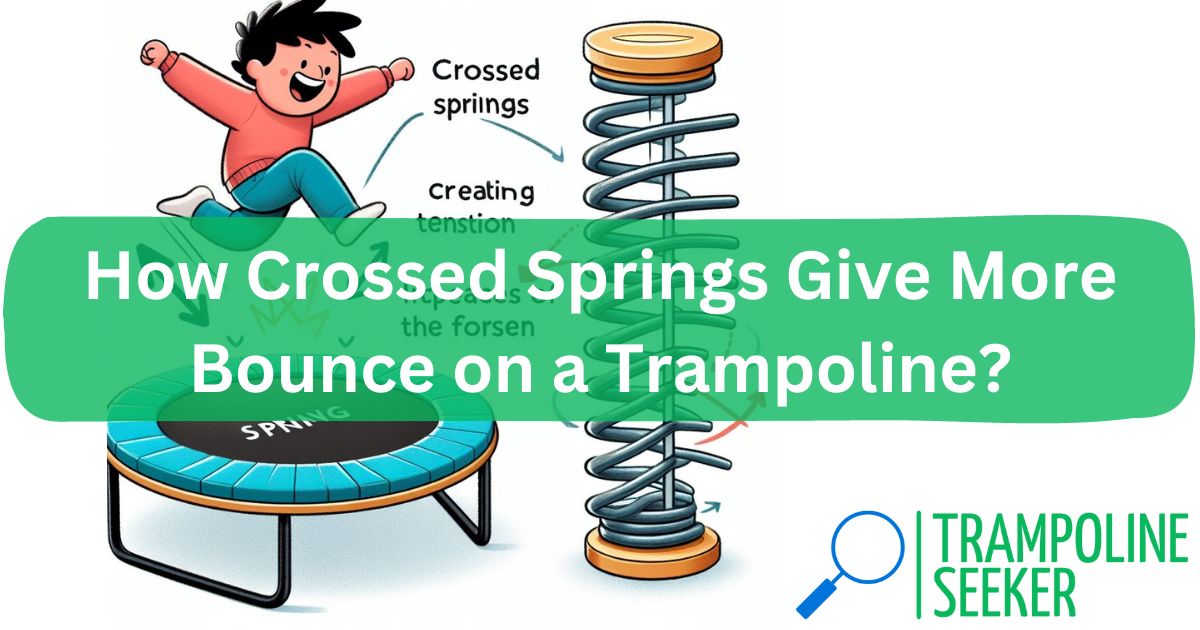Can you use a trampoline once old man winter arrives? I explored the internet to find the answer. After analyzing numerous articles on trampolining in cold temperatures, I compiled the key information into this blog post.
The short answer: Yes, you can jump on a trampoline in frigid weather, with some precautions. How cold is too cold? Read on to learn the temperature thresholds for safe and enjoyable trampoline use.
My Trampoline Cold-Weather Experiments

As a regular trampoline jumper living in chilly Edmonton, I was determined to use my trampoline even during the winter. One night, when the temperature dipped below zero degrees Fahrenheit, I ventured out in my warmest winter gear for a bounce session. To my surprise, the trampoline still had plenty of spring and bounce, although my landings felt harder with bulky boots. After a few minutes of jumping jacks and seat drops my body heat rose considerably. I lasted 10 minutes before retreating inside to warm up with a cup of hot cocoa.
This first cold trampoline test was a success! But, I wondered – how low can the mercury go before it becomes unsafe or impossible to jump? Does cold temperature damage trampoline parts? I scoured the internet to find out.
How Cold Temperatures Affect Trampoline Jump Performance

Trampolining in cold weather does feel different than during warmer months. Colder air is denser, which provides more resistance. This can affect jump height and aerial control. The table below outlines how trampolining feels at various temperatures:
| Temperature | Jump Experience |
|---|---|
| 75°F + | Normal |
| 60°F – 75°F | Less bounce, more control |
| 45°F – 60°F | Stiffer mat and springs, higher effort jumps |
| 30°F – 45°F | Hard mat with light bounce, loss of air control |
| 15°F – 30°F | Very stiff mat, shoes slip on mat |
| < 15°F | Frozen mat, barely bounces – don’t jump! |
In general, the trampoline will still function for jumping in temperatures down to about 30°F. However, you need to dress very warmly and use caution. Colder than that, frost and ice accumulation on the mat can create slippery and hazardous conditions.
Safe Temperature Thresholds for Trampoline Use
Trampolining is an intense full-body workout that generates plenty of internal body heat. So even if the weather is frosty, you can potentially get in some safe jump time.
How cold is too cold? Experts suggest avoiding the trampoline once temperatures drop below 20°F (-6°C). The mat loses most of its bounce by this point. And frozen springs could snap and cause injuries.
As for hot weather, manufacturers typically specify a max use temperature of 140°F (60°C). On extremely hot days, the mat can get hot enough to burn skin. The heat also accelerates deterioration of the materials.
So the safe atmospheric temperature range for trampoline use is approximately 20° to 140° Fahrenheit. Stay within these boundaries and you can jump all year round!
Pro Tips: Enjoy Your Trampoline in Cold Weather
Bitterly cold temps need not relegate your tramp to the garage until spring thaw. Here are my top tips for safe winter trampolining:
Check for frost – Inspect the mat before stepping onto it. Brush off any frozen moisture so it doesn’t melt and create puddles.
Wear winter boots – Lug-soled winter footwear provides traction on stiff mats. Just remove ice cleats to avoid damage.
Layer up top & bottom – Wear insulated snow pants over sweatpants, plus jacket, hat, scarf and gloves. Shed layers as you warm up.
Limit jump time – Start with only 5-10 minutes of bouncing before taking a warming break inside. Listen for cracking springs.
Avoid ice buildup – Brush heavy snow off the mat so it doesn’t freeze into slippery ice sheets.
Follow these tips and your trampoline can survive and thrive through harsh winters! Just use good judgment when temperatures drop into the extremes.
How Cold Temperatures Affect Trampoline Parts
I discovered that winter weather has minimal impact on the durability of trampoline components. Here’s the breakdown:
Mat – Polypropylene mats retain flexibility and bounce in cold temperatures. An ice coating causes slipping rather than mat damage. Once thawed, the mat regains its grip.
Springs – Metal springs resist winter corrosion and function fine until ice literally freezes them in place at very low temperatures.
Frame – Steel, aluminum and galvanized metal frames withstand winter weather without issue. Some plastic components can crack.
Safety Net – Nets remain intact through winter but ice accumulation causes sagging. Thawing refreshes them.
So rest assured that your trusty tramp won’t suffer cold weather damage, as long temperatures remain 20°F or warmer.
Enjoy Winter Trampoline Activities
Beyond simply bouncing, enjoying your trampoline in creative ways during winter can burn energy and banish boredom when outdoor options are limited. Here are some to try:
Snow clearing – Shovel snow off using energetic squats and throws. Just avoid dumping it directly on the mat.
Mat jogging – Jog in place while practicing high knees and butt kicks.
Agility drills – Hop sideways, front and back across the mat to improve coordination.
Calf raises – Stand facing the edge and rise up and down on tip-toes to sculpt calves.
Seated exercises – Sit toward the edge and train your core and arms isometrically.
Trampoline Care and Maintenance in Winter
Take proper care of your trampoline when it’s not in use and it will last for many years through extreme weather conditions. Follow these winter trampoline care tips:
Brush off snow – Clear snow before it compacts into dense ice. A stiff broom works well.
Prevent piled snow – Don’t let adjacent snowbanks dump onto the mat. The weight can damage it.
Check for tears – Inspect the mat regularly for new rips and holes to repair before they expand.
Store safely – Place the trampoline on level ground and tie down the frame if needed.
Weatherproof pads – Cover pads with waterproof tarp to prevent deterioration over winter.
With conscientious care, your trampoline can survive another winter and provide year-round fun.
Other Related Blogs:
- How to Winterize a Trampoline?
- Can a Trampoline Stay Out in the Winter?
- How to Clean a Trampoline After Winter?
The Bottom Line – Enjoy Trampolining Down to 20°F
After scouring trampoline forums and reading Product manuals, I have concluded that outdoor trampolining is feasible in temperatures down to about 20°F (-6°C). The mat will be very taut at this point, with minimal bounce. Still, with layers of warm winter gear, you can get the heart pumping and practice skill drills.
For casual bouncing fun, aim for 45°F+ days. At this warmer threshhold, the mat regains some spring and you can jump longer without freezing. Use common sense about ice conditions and dress appropriately for the conditions.
Stay tuned for my next experiment: night trampolining by the magical glow of floodlights and colorful string lights! Tramp on!
Frequently Asked Questions
Can you use a trampoline in the snow?
Yes, light snowfall won’t harm a trampoline mat. Just clear any deep accumulation to prevent it from compacting into dense ice sheets. Use a stiff broom to sweep off the mat before use. Avoid trampolining in icy conditions as this greatly increases injury risk from slips and falls.
Does cold weather break trampolines?
Frigid temperatures rarely damage trampoline parts. However, jumping vigorously on a fully frozen trampoline can potentially snap springs and cause accidents. Cease use when you detect ice accumulation on mats and pads. Temperatures below -20°F (-29°C) may start to damage synthetic components like nets, straps and padding.
Can you jump on a trampoline at 0 degrees?
Technically you can jump on a trampoline in 0 degree weather. However, performance will be poor and injury risk elevated. At this extreme temperature, the tightly coiled springs offer very little bounce. And frozen moisture makes landing slippery. Wait until temperatures climb closer to 32°F (0°C) for better, safer trampoline jumping.
Should I take my trampoline down for winter?
Taking down a trampoline for winter is unnecessary unless you live in an area with very extreme subzero temperatures for months. An intact trampoline withstands light snow and cold. Just protect the surface from excessive buried snow weight. Taking it apart each winter and reassembling the following spring does create unnecessary wear and tear over time.
Articles You May Like to Read:













